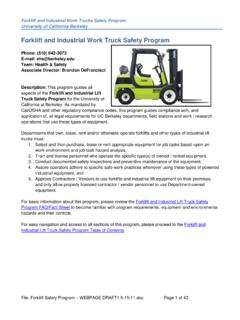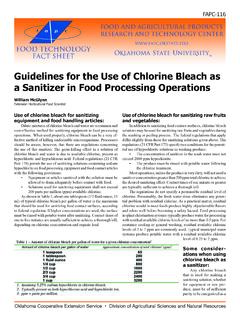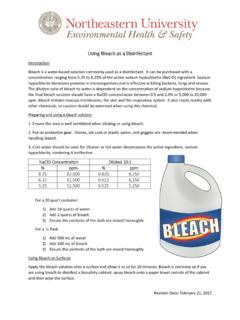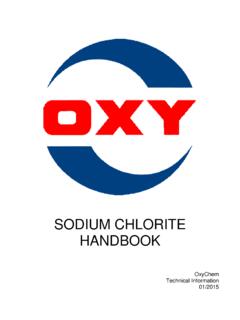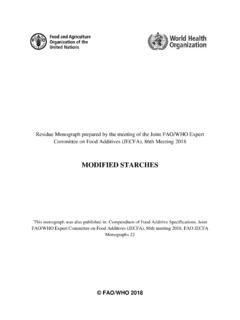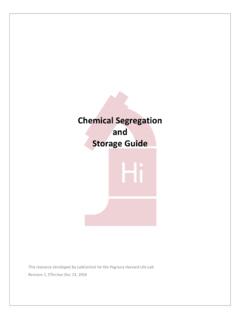Transcription of Environment, Health & Safety Hazardous
1 General AssistanceEmergency Phone NumbersDepartment ContactsLife-threatening Emergenciesland line911cell phone(510) 642-3333 Hazardous Material Spillsbusiness hours(510) 642-3073 EH&S off -hours & weekends(510) 642-6760 UCPDF acilities Services24 hour contact(510) 642-3073 Environment, Health & Safety (510) 642-3073business hoursNamePhone NumberDepartment Safety CoordinatorBuilding CoordinatorLab or Shop Emergency ContactSafe Storage ofHazardousChemicalsOffice of Environment, Health & SafetyOffice of Environment, Health & Take Inventory of Your Chemicals Label Your Chemicals Segregate Incompatibles 5 Common Incompatibles Basic Storage Requirements Chemical Storage Guide: Individual Hazards and Mixed Hazards 11 Flammables and Combustibles 14 Corrosives 17 Toxics 19 Highly Toxics 20 Oxidizers 22 Compressed Gases 24 Cryogens 26 Pyrophorics (Air Reactives) 28 Water Reactives 29 Explosive and Potentially Explosive 30 Peroxide Forming Chemicals 34 Page123 IntroductionThe safe storage of Hazardous chemicals is an essential part of an environmental, Health , and Safety program.
2 Chemical storage facilities must meet certain minimum standards to satisfy diverse regulations, such as those of Cal/OSHA, the local sanitary district, and the California Fire Code. This manual provides guidelines to help you meet these addition, laboratories and work areas on campus must observe several requirements that incorporate safe storage: Keeping an up-to-date chemical inventory Maintaining a chemical hygiene plan and documenting staff training Conducting annual self-inspectionsEH&S provides more information on the above programs at its website five sections of this brochure cover the main elements of a safe chemical storage program:Section Information 1 How to Maintain an Accurate Inventory of Hazardous Chemicals 2 Proper Chemical Labeling 3 Segregating Incompatible Chemicals 4 Providing Basic Storage Needs 5 Storing Chemicals according to their Hazardous CharacteristicIllustrations by Oruc Label Your ChemicalsAll Hazardous chemicals must be clearly labeled for the benefit of current users, emergency personnel, and future users.
3 Unknown chemicals can be expensive to dispose of. Make sure all labels are legible and in good condition. Repair or replace damaged or missing labels. Manufacturers Labels Cal/OSHA requires that manufacturers provide labels with the following information: contents of the container physical and Health hazard information name, address, and emergency phone number of the manufacturer or other responsible partyOriginal manufacturers labels must not be removed or defaced. Material Safety Data Sheets (MSDSs) must be accessible to anyone working with these chemicals. Electronic format MSDSs are available from the EH&S web site at h t t The MSDS may also provide useful storage Own LabelsHazardous chemicals that are not in the manufacturer s original container ( , working solutions prepared in the lab) must, at a minimum, be labeled with the contents of the container. If the contents are Hazardous , attach a label indicating the hazard to warn individuals in the work area.
4 It is not necessary to label containers that will be used temporarily (during one work shift) and are under your immediate your an extra copy of your inventory handy at a central Take Inventory of Your ChemicalsSafe storage begins with an up-to-date inventory of Hazardous chemicals that can be used to apprise personnel of the dangers in a laboratory, shop, or work area. An accurate inventory is also necessary if emergency responders are to respond effectively to a fire or chemical release in the area. The campus can be fined if it does not provide an inventory to emergency response personnel and appropriate regulatory Office of Environment, Health & Safety (EH&S) coordinates the collection of chemical inventories for the campus. Submit your inventory to EH&S annually. Also submit one whenever the maximum amount listed for a particular chemical changes by more than 50 percent or you obtain a chemical that was previously not reported.
5 Immediately notify EH&S if a laboratory or other area has been cleaned out or a new laboratory has started up or moved. The annual review of your chemical inventory is a prime opportunity to clean out unwanted chemicals. Your unwanted chemicals will either be picked up and disposed of or collected for reuse through the campus Chemical Exchange Program (CHEX). Visit the EH&S web site ( ) for Fact Sheets about CHEX and disposal of unwanted Hazardous Incompatible chemicals within the same hazard class should also be separated from one another. For example, both nitric and perchloric acids are incompatible with organic acids (such as acetic acid) and should not be stored together. Most labs have limited space, but the following priorities may help you decide how to store the chemicals. Do not store chemicals alphabetically unless they are compatible. Store flammable liquids in approved Safety containers in flammable storage cabinets.
6 Do not store anything but flammable or combustible liquids in these cabinets. Segregate acids from bases. Segregate most organic acids from oxidizing mineral acids. Keep oxidizers away from other chemicals, especially flammables, combustibles, and toxic materials. Keep corrosives away from substances that they may react with and release corrosive, toxic, or flammable Hazard Classes Many chemicals belong to more than one chemical family or hazard class. In such cases, all storage rules must be strictly observed. For example, acetic acid is both a corrosive acid and a combustible liquid. It must be stored away from corrosive bases, such as sodium hydroxide, and also from oxidizing acids, such as nitric More InformationFor more specific information, use the storage guidelines that follow. You can obtain labels and material Safety data sheets (MSDSs) from the manufacturer, your department, or EH&S. MSDSs provide information on chemical Segregate IncompatiblesChemical Families Materials should always be segregated and stored according to their chemical family or hazard classification.
7 Do not store chemicals alphabetically unless they are compatible! The most common hazard classes include: flammables/combustibles corrosive acids corrosive bases toxics highly toxics oxidizers compressed gases cryogens pyrophorics water reactives explosivesAccidental contact between incompatible chemicals can result in a fire, an explosion, the formation of highly toxic and/or f lammable substances, or other potentially harmful reactions:Oxidizers mixed with f lammable solvents can cause a fire. Acids mixed with metal dust can produce f lammable hydrogen storage can bring incompatibles together. For example, if chromic acid (an oxidizing acid) and chromium powder (a combustible metal) were stored together and an accident broke their containers, the chemicals could mix and react with explosive violence. Segregate FamiliesEach chemical family should be separated from all other chemical families by an approved non-combustible partition or by a distance of twenty feet.
8 Ideally, each hazard class would be kept in a cabinet or on a shelf segregated from other hazard 89 Chlorineammonia, acetylene, butadiene, benzene, other petroleum fractions, hydrogen, sodium carbide, turpentine, finely divided powdered metalsCyanidesacidsHydrogen Peroxidecopper, chromium, iron, most metals or their respective salts, f lammable liquids or combustible materials, aniline, nitro-methaneHydrogen Sulfidenitric acid, oxidizing gasesHydrocarbons (general)halogens, chromic acid, sodium peroxideIodineacetylene, ammonia, chlorineMercuryacetylene, ammonia, lithiumNitric Acidacetic, chromic, and hydrocyanic acids, aniline, carbon, hydrogen sulfide, flammable material, readily nitrated substancesOxygenoils, grease, hydrogen; f lammable materialsOxalic Acidsilver, mercury, chlorites, strong oxidizersPerchloric Acidacetic anhydride, bismuth and its alloys, alcohol, paper, wood, other organic materialsPotassium Permanganateglycerine, ethylene glycol, benzaldehyde, sulfuric acidSodium Peroxideany oxidizable substancesSulfuric Acidchlorates, perchlorates, Common IncompatiblesDo not store incompatible chemicals in close proximity to each other.
9 In an earthquake, fire, or other spill, they could mix and react violently and/or release poisonous Material Incompatible withAlkali metals like calcium, potassium, and sodiumwater, carbon dioxide, carbon tetrachloride, other chlorinated hydrocarbonsAcetic Acidchromic acid, nitric acid, hydroxyl-containing compounds, ethylene glycol, perchloric acid, peroxides, permanganatesAcetoneconcentrated sulfuric or nitric acid mixturesAcetylenecopper (tubing), halogens, silver, mercury, and their compoundsAmmonia, Anhydrousmercury, halogens, calcium hypochlorite, hydrogen f luorideAmmonium Nitrateacids, metal powders, f lammable liquids, chlorates, nitrates, sulfur, finely divided organics or combustiblesAnilinenitric acid, hydrogen peroxideBromineammonia, acetylene, butadiene, butane, hydrogen, sodium carbide, turpentine, finely divided metalsChloratesammonium salts, acids, metal powders, sulfur, carbon, finely divided organics, combustiblesChromic Acidacetic acid, naphthalene, camphor, alcohol, glycerine, turpentine, other f lammable liquids or combustible materials1011 Storage CabinetsUse only approved storage cabinets.
10 Never alter a f lammable storage cabinet unless directed to do so by EH& cabinets with the hazard class of the ShelvesShelves should be level, stable, and secured to the wall or another stable case of an earthquake, shelves should have raised edges or rim guards (minimum height of 2 inches) to prevent containers from falling. Use bungee cords for added should be kept free of chemical contamination and should be located away from direct sun, f lame, and heat should not protrude over shelf large bottles/containers no higher than 2 feet from the f loor. Store corrosives on lower ContainersKeep containers closed unless you are dispensing a chemical or adding to the container. Never store a container open with a funnel in secondary containment for liquids in containers larger than 1 gallon in size. Dishpans or polyethylene trays work approved containers for f lammable Basic Storage RequirementsThe following basic storage requirements apply to all Hazardous chemicals.


